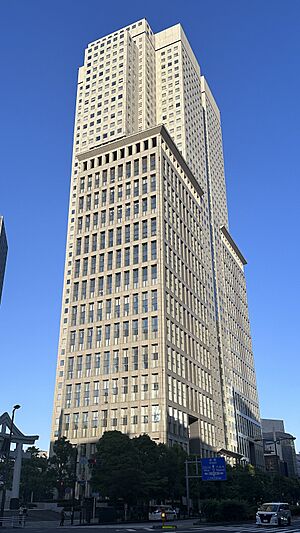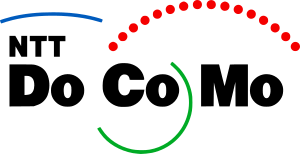NTT Docomo facts for kids

Sanno Park Tower, home of NTT Docomo's headquarters
|
|
|
Native name
|
株式会社NTTドコモ
|
|---|---|
|
Romanized name
|
Kabushiki gaisha Entiti Dokomo |
| Subsidiary KK | |
| Industry | Telecommunications |
| Founded | 14 August 1991 |
| Headquarters | Sanno Park Tower Nagatachō, Chiyoda, Tokyo, Japan |
|
Key people
|
Kazuhiro Yoshizawa (CEO) |
| Products | PDC, i-mode, W-CDMA, FOMA, HSDPA, LTE, 5G NR, PHS |
| Revenue | |
|
Operating income
|
|
| Total assets | |
| Total equity | |
|
Number of employees
|
27,558 (2019) |
| Parent | NTT, Inc. |
| Divisions |
|
| Subsidiaries |
|
|
|
|
NTT Docomo, Inc. (also known as Docomo) is a big Japanese company that provides mobile phone services. It is owned by Nippon Telegraph and Telephone (NTT). The name "Docomo" is a clever abbreviation for "do communications over the mobile network." It also sounds like the Japanese word doko mo, which means "everywhere."
Docomo's main office is in Sanno Park Tower in Tokyo, Japan. The company offers many services, including phone calls, video calls, internet access (called i-mode), and messaging. Docomo is the largest wireless carrier in Japan, with over 82 million customers as of March 2021.
The company started in August 1991 when it was separated from NTT to handle mobile phone operations. NTT kept most of the company's shares until 2020, when Docomo became fully owned by NTT again. Docomo has offered different generations of mobile services, from 2G to 5G.
Contents
Connecting People: Docomo's Services
NTT Docomo is a part of Japan's main telephone company, NTT. Most of Docomo's shares are owned by NTT. This means that Japanese interests, including the government, have control over the company. Docomo provides wireless voice and data services to its customers in Japan.
Docomo created the W-CDMA technology, which is used for 3G mobile services. They also developed the popular i-mode service, which gives mobile phones access to email and the internet.
Mobile Service Milestones
Docomo has always been at the forefront of mobile technology in Japan.
- They had over 53 million customers by March 2008, which was more than half of Japan's mobile phone users.
- In 2001, they launched FOMA, the world's first 3G mobile service based on W-CDMA technology.
- On December 24, 2010, they launched Xi, their 4G LTE mobile service.
- On March 27, 2015, they introduced Premium 4G, an even faster LTE Advanced service.
- Most recently, on March 25, 2020, Docomo launched its 5G service, making Japan one of the first countries to have 5G.
Global Connections
Docomo has offices in Europe and North America. They also work with other mobile companies in Asia-Pacific and Europe to expand their services worldwide. Docomo's shares are traded on stock exchanges in Tokyo, London, and New York.
In 2008, Ryuji Yamada became the president of NTT Docomo. This change happened after Docomo lost some customers to other mobile providers like KDDI and SoftBank. This was partly because customers could keep their phone numbers when switching providers. Docomo was also one of the last major mobile companies to offer Apple's iPhone, which led some customers to switch to other networks.
In 2011, Docomo partnered with McAfee to offer McAfee VirusScan Mobile to its Android phone users. In 2012, NTT Docomo bought an Italian company called Buongiorno.
Exploring New Ideas: Research and Development
Docomo is always working on new technologies.
- In October 2007, Docomo and Mitsubishi Electric showed off a special mobile phone. This phone could check a person's health by tracking their movement, measuring calories, and even included a breath analyzer.
- In January 2008, NTT Docomo announced a partnership with Google. This allowed newer phone models to watch YouTube videos.
- In 2008, NTT Docomo helped start the Symbian Foundation, which worked on smartphone operating systems.
Advancing Mobile Technology
Docomo has been a leader in bringing new mobile network speeds to Japan.
- In May 2017, Docomo started testing 5G networks in Tokyo.
- They officially launched their 5G network on March 25, 2020. This made them the first Japanese company to offer 5G.
Future of Communication
Docomo is also looking into even newer technologies.
- In August 2021, Docomo and Airbus tested a special solar-powered aircraft called a Zephyr High Altitude Platform Station (HAPS). This aircraft flies very high in the stratosphere and can transmit data for 5G and even 6G networks.
- The test lasted 18 days in the United States. If successful, this technology could help provide communication services to remote islands, mountains, and even ships at sea.
Staying Safe: Warning Systems
Docomo provides important services to help keep people safe in Japan.
Earthquake Early Warning
Since 2008, Docomo has offered a service called the "Area Mail Disaster Information Service." This service sends Earthquake Early Warning messages to its customers' phones. These messages come from the Japan Meteorological Agency. The service is free, and messages are only sent to areas that will be affected by an earthquake. These alerts have a special sound so people know it's an important warning.
Civil Protection Alerts
Since 2014, Docomo has also offered the "Area Mail Disaster and Evacuation Information Service." This service broadcasts J-Alert messages, which include earthquake warnings and other important alerts. These messages come from the Japan Fire and Disaster Management Agency. They are sent to compatible phones when there are immediate threats, such as missile launches, terrorist attacks, volcanic eruptions, or tsunamis.
Docomodake: The Friendly Mascot
Since 2005, Docomo's mascot has been a cute mushroom named Docomodake. He is very famous in Japan!
- Docomodake even starred in his own Nintendo DS video game called Boing! Docomodake DS.
- You can find lots of Docomodake merchandise, like phone straps, keychains, and plush toys.
- There are many different types of Docomodakes, like Mother and Father Docomodake, which represent the different mobile plans Docomo offers.
Emoji: A New Way to Express Yourself
Shigetaka Kurita, who worked on NTT DoCoMo's i-mode mobile internet platform, is often given credit for creating the first emoji. However, another company called SoftBank released their own emoji set earlier in 1997.
The company or organization that creates an emoji usually owns its copyright. For example, Apple owns the copyright for its emoji designs. Companies like Facebook, Twitter, and WhatsApp own the copyright for the emoji used on their platforms.
Emoji are made standard by the Unicode Consortium. This group sets rules for how emoji should look and what they mean. But individual companies can still design their own unique versions of emoji within these rules.
Hikari TV: Entertainment at Home
Hikari TV is a Japanese service that provides TV channels over the internet. It started in 2008 and was first owned by NTT Plala. In 2013, Hikari TV launched Hikari TV Game, which was the first cloud gaming service for TVs in Japan.
On July 1, 2022, NTT Docomo took over NTT Plala, and Hikari TV became a part of Docomo's services. Hikari TV offers many TV channels and also creates its own shows, mainly for the Hikari TV Channel.
See also
 In Spanish: NTT DoCoMo para niños
In Spanish: NTT DoCoMo para niños
- Japanese mobile phone culture
- NTT Docomo USA



